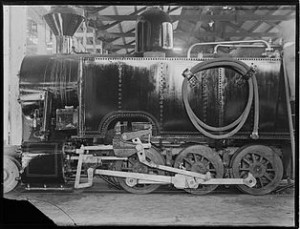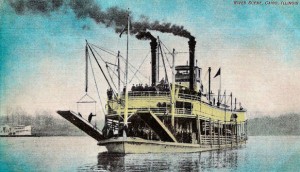By Elyse Salisz
“The wonderful progress of the present century is, in a very great degree, due to the invention and improvement of the steam engine, and to the ingenious application of its power to kinds of work that formerly taxed the physical energies of the human race.” -Robert H. Thurston (Bolon, 2001)
The refinement of the steam engine by James Watt was vital to the Industrial Revolution taking place throughout Europe. One of the most important beneficiaries of the steam engine was transportation. Before the steam engine, transportation relied on man and animal power, making transporting goods and materials, long and tedious ventures. Steam power overcame those limitations and increased factory and trading efficiency and growth at a pace never seen before.
The steam engine’s reputation for efficiency was growing beyond just mining and spread to other industries such as textiles and metalworking. The steam engine adapted to the rotating wheel system which became common in mill and factories throughout Europe. Factories had previously been confined to areas with abundant wind and water resources, so they had power to drive their machines. The refinement of the steam engine meant that factories could be built anywhere they were needed and not only made production more efficient but also produced better quality materials.

Engine Room 1903-Mainova AG
by Mainova, used under 
The steam engine had become compact enough by the early 1800’s to move beyond factories and by 1804 the first steam powered locomotive hit the rails. This was the first time goods and materials were able to be transported on land by something other than man or animal power. The use of the steam engine in locomotives was a rebirth for the entire industry. Transportation was becoming a more efficient business, as it took less time to go farther distances and was more secure overall. Also, due to the locomotives greater reach, small villages and areas that were more rural had reduced chances of food shortages. This growth in the industry also opened up a need for a massive workforce to manage and maintain the factories and the railway lines.

A steam tank locomotive from The Powerhouse Museum
by Clyde works in Granville, NSW, used under
Steam powered locomotives were no longer just used for transporting goods, by 1825 commuter traffic to large cities increased so rapidly that passenger locomotives were becoming more and more common. Boats were another beneficiary of the steam engine, transporting both goods and people. The steam boat was more efficient, as they were larger and able to travel at a faster pace relying on steam power instead of wind.

River Scene, Cairo, Illinois
by Creator:Curt Teich & Co., Chicago, Ill., used under 
The world would not be the same if it were not for the refinement of the steam engine and the industrial revolution would have never progressed as much as it did without the power and efficiency the steam engine provided. Not only was it the foundation for all mechanical technology that we use today but the steam engine revolutionized the world of transportation.
